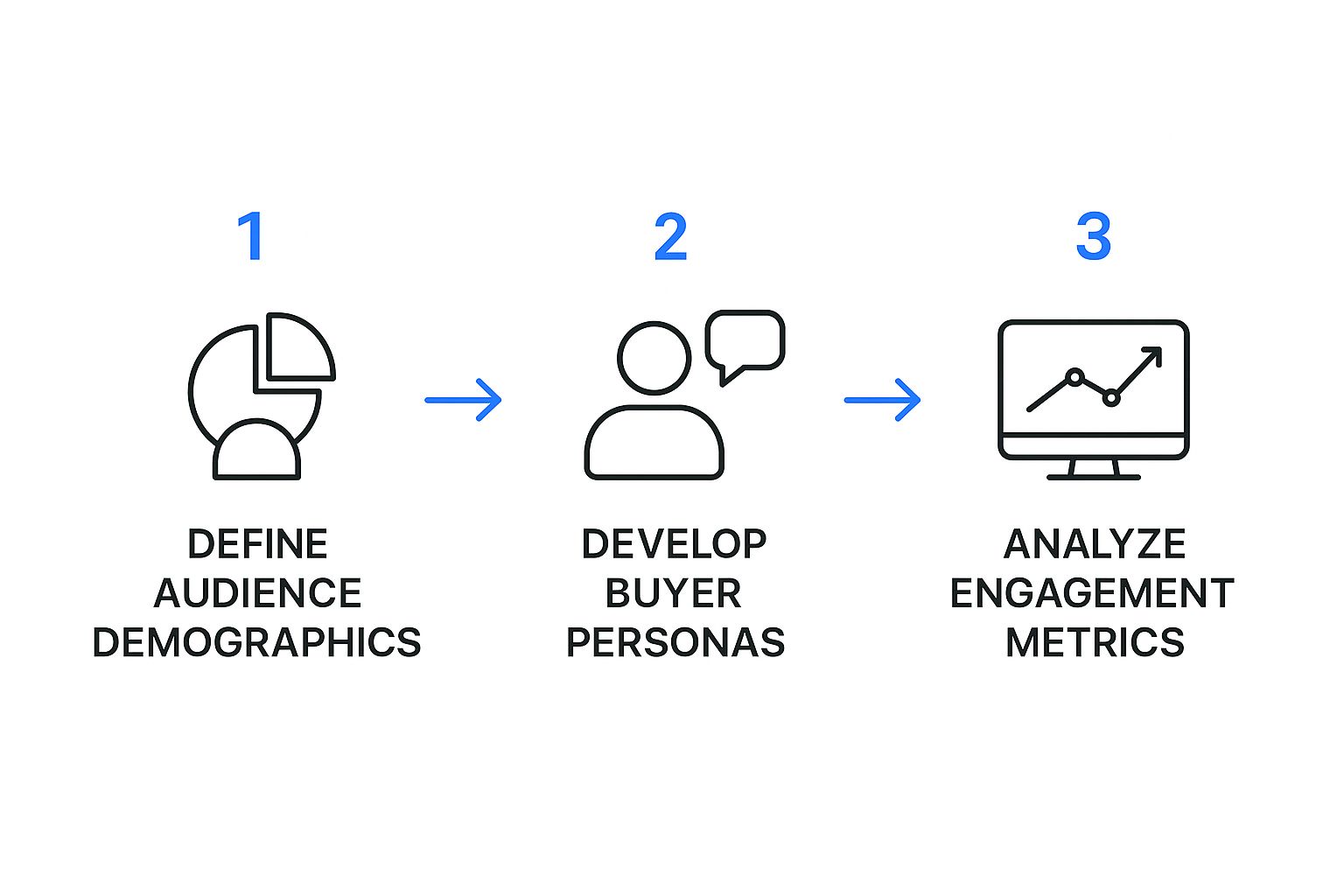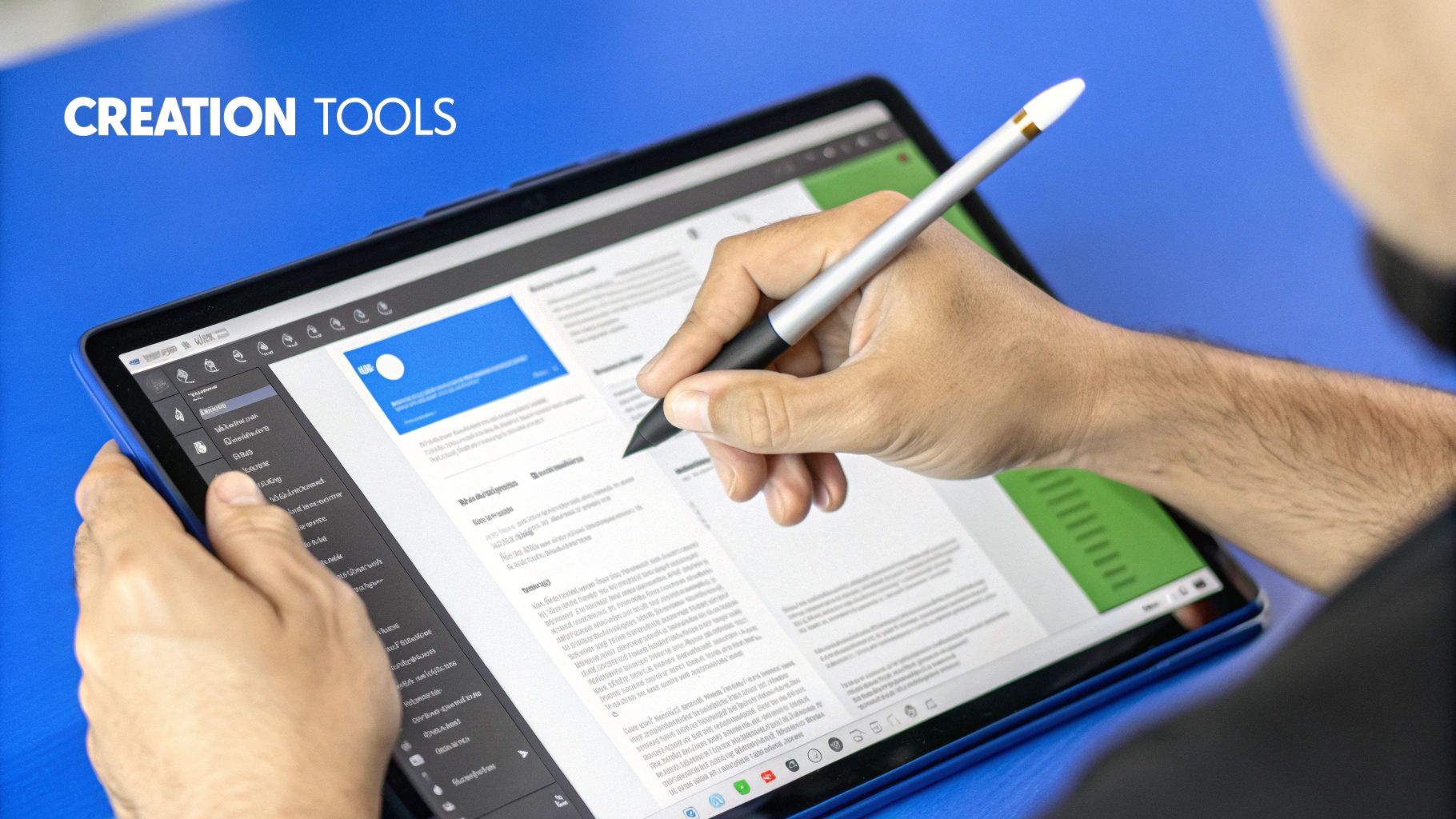For most small business owners, creating content feels like one more thing on a never-ending to-do list. I get it. But thinking of it that way misses a huge shift in how people decide to buy things today.
They aren't just responding to ads anymore. Before they even think about making a purchase, they're out there looking for expertise, authenticity, and a real connection. This is where your content engine kicks in.
Why Your Business Needs a Content Engine

A content engine isn't about posting randomly and hoping for the best. It’s a systematic way to plan, produce, and publish valuable stuff that pulls in your ideal audience, keeps them interested, and eventually turns them into customers. It moves you from "random acts of marketing" to a repeatable process that builds your brand's authority day in and day out.
The Modern Customer Journey
Today’s customers are researchers. Full stop. They hit up search engines and scroll through social media to find answers, compare their options, and make sure they’re making a good choice. Your content is what they discover during this critical phase. If you don't have any, you're basically invisible online.
When you consistently put out high-quality content, it does a few critical jobs for you:
- It Builds Trust: Sharing your expertise and offering real solutions shows you know your stuff. This positions your brand as a credible, go-to authority.
- It Drives Traffic: Every single blog post, video, or social media update is another doorway for new customers to find you.
- It Nurtures Leads: Good content keeps your business on people's minds, gently guiding them from just hearing about you to actually buying from you.
Small Business Content in Action
Let’s make this real. Think about a local bakery that shares quick video tutorials on cake decorating. They're not just selling cakes; they're selling their expertise and building a community of fans.
Or how about a financial advisor who writes weekly blog posts that break down complicated investment topics into plain English? This kind of content creation for small business builds the deep trust someone needs before they’ll hand over their life savings.
A smart content plan is no longer optional—it's the primary way small businesses compete and grow. Your stories, expertise, and solutions build the authority that converts followers into loyal customers.
The numbers back this up. Over 96% of small businesses are now using social media for marketing, and for 83% of them, the number one benefit is increased brand visibility. Platforms like Instagram are at the heart of these efforts, with most users saying they find engaging content from brands right there in their feed.
This digital-first world is exactly why a solid grasp of video marketing for small business is more critical than ever.
To get you started, think about your content in terms of "pillars"—core topics that directly support your business goals. Here’s a simple table to help you map it out.
Essential Content Pillars for Small Business Growth
This table breaks down the core content types small businesses should prioritize to hit specific business goals.
| Content Pillar | Primary Business Goal | Example Format |
|---|---|---|
| Educational How-Tos | Build Authority & Trust | Blog post, short video tutorial, checklist download |
| Behind-the-Scenes | Foster Community & Connection | Instagram Story, "day in the life" video |
| Customer Success Stories | Provide Social Proof | Video testimonial, written case study, quote graphic |
| Product/Service Demos | Drive Sales & Conversions | Short video showing the product in action, webinar |
By focusing on these key pillars, you can create a balanced content strategy that not only attracts an audience but also guides them toward becoming customers.
Building a Realistic Content Strategy
Jumping into content creation without a plan is like starting a road trip with no map—you’ll burn a lot of fuel and end up going in circles. A solid strategy is what separates businesses that just make noise from those that actually connect with their audience. It ensures every single piece of content you produce has a job to do.
It all starts with a simple, but crucial, question: who are you really talking to? It’s not enough to have a fuzzy idea of your customer. You need to dig deep into their goals, their biggest frustrations, and the online spaces where they actually hang out. Once you truly get them, making content they love becomes almost second nature.
This graphic really nails the process of turning broad ideas about your audience into real, usable insights.

As you can see, it's not a one-and-done task. Defining your audience is a constant loop of learning from your engagement and tweaking your approach.
Define Your Core Content Pillars
Okay, so you know your audience. Now, it's time to figure out what you’ll talk about by setting up your content pillars. These are the 3-5 core topics your brand is going to be known for. Think of them as the intersection of what your audience is dying to learn and what your business is an expert in.
For a local accounting firm, these pillars might be:
- Small Business Tax Tips
- Bookkeeping Best Practices
- How to Read Financial Statements
And for an e-commerce shop selling sustainable home goods, they could look like this:
- Eco-Friendly Living Guides
- Product Spotlights & Sourcing Stories
- Zero-Waste Home Hacks
These pillars will be your north star, keeping every piece of content you create focused, relevant, and on-brand. This tight focus is a key part of many effective content strategy principles that top brands swear by.
Conduct a Quick Competitor Check
You don't need a massive, spreadsheet-heavy analysis here. Just take a quick peek at what others in your field are doing. The goal isn't to copy them—it's to find the gaps they've left wide open. What questions are they completely ignoring? What formats are they not even touching?
A competitor check is your chance to find the conversations your audience is having where nobody is taking the lead. By spotting these content gaps, you can position your small business as the go-to resource in an underserved niche.
For example, if all your competitors are churning out long blog posts, maybe there’s a massive opportunity for you to create short, snappy how-to videos for TikTok or YouTube Shorts. If they’re all just talking about product features, you can stand out by sharing customer stories or behind-the-scenes glimpses. This is how you carve out a space that's uniquely yours.
Choose Your Platforms Wisely
Fight the urge to be everywhere at once. It's far better to be a big deal on one or two channels than to be a forgettable presence on five. The key is to go where your ideal customer already is. If you're a B2B consultant, LinkedIn is probably your best bet. If you sell beautiful, visual products, Instagram and Pinterest are where you need to be. Put your energy where it's going to make the biggest splash.
With a clear strategy in place, your content creation for small business stops being a source of stress and starts being a predictable engine for growth. And once you have your roadmap, you can start exploring the top AI tools for content creators to help bring your vision to life even faster.
Using AI as Your Content Co-Pilot
Let's be honest: for any small business owner, time is the one thing you can never get more of. The idea of "Artificial Intelligence" might sound like something out of a sci-fi movie, but in reality, it's the most practical assistant you could ask for—a co-pilot that helps you create better content, faster.
This isn't about replacing your unique voice or expertise. It’s about amplifying it by letting AI handle the grunt work.
Think about it. You record one great customer testimonial video. With the right tools, that single video can become a week's worth of social media clips, a highlight for your email newsletter, and even the script for a future ad. This kind of efficiency used to be reserved for big companies with big budgets, but AI-powered tools put that power right in your hands. It makes consistent content creation for small business totally achievable, even if you're a team of one.
Streamlining Your Workflow with Smart Tools
The real magic of AI is how it tackles the repetitive, time-sucking tasks that bog you down. Instead of staring at a blank page for hours trying to dream up blog topics, an AI tool can spit out dozens of relevant ideas in seconds, all based on your industry and ideal customer.
This frees you up to do what only you can do: tell your story and build real connections.
To get the most out of AI for content, tools like ChatGPT can be a game-changer for finding keywords and structuring your articles. If you want to go deeper on that, this guide is a fantastic resource: A Practical Guide to ChatGPT for SEO.
It's no surprise that 81% of B2B marketers are already using generative AI. But here's the catch: a staggering 38% of marketers say their company's tech isn't being used to its full potential. This just proves that having the tools isn't enough—you need a smart strategy to go with them.
From One Video to a Full Campaign
Let's walk through a real-world example. Say you just recorded a 10-minute video explaining a new service you offer. In the past, manually chopping that up into bite-sized, engaging clips for different platforms would have eaten up your entire afternoon. This is exactly where specialized AI platforms come in.
Tools like ShortsNinja were built for this. They make content repurposing ridiculously simple. Just look at how clean the workflow is.

You just feed it your long video, and the AI does the rest. It automatically finds the most compelling moments, slaps on captions, and formats them perfectly for TikTok, YouTube Shorts, and Instagram Reels. Just like that, one piece of pillar content becomes a dozen ready-to-post assets.
AI doesn't just make content creation faster; it makes it smarter. By automating the tedious parts of the process, you can focus your energy on strategy, creativity, and building genuine connections with your audience.
By using AI this way, you can maintain a strong, consistent presence across all your channels without running yourself into the ground. It’s all about working smarter, not harder.
Crafting Content That Actually Connects
Look, great content isn't about listing product features or droning on about facts. That’s what brochures are for. If you want to build a real business, your content needs to create a genuine connection with your audience.
Information tells people what you do, but storytelling shows them why it matters. This is the secret sauce that takes you from being just another option in a crowded market to becoming their go-to choice.
The trick is to stop talking about yourself and start framing everything through your customer's eyes. Forget "advanced features"—what frustrating, hair-pulling problem does your service actually solve for them? A simple but powerful way to structure your content is around a Problem-Solution-Result narrative. Show them you get their struggle, position your product as the hero that saves the day, and then paint a vivid picture of their life after your help.
Develop an Authentic Brand Voice
Your brand voice is just your business's personality. It needs to show up consistently in every blog post, video, and social media update. Are you the wise, helpful expert? The quirky best friend? The no-nonsense professional?
There's no right or wrong answer, but it absolutely has to feel authentic to you and click with your ideal customer.
To nail this down, ask yourself three simple questions:
- If my business were a person, what three words would describe it? (e.g., "friendly, reliable, simple")
- What's my relationship with my customers? (e.g., "a trusted guide," "a supportive peer")
- If my brand walked into a room, what vibe would it give off?
Answering these helps you stop sounding like a corporate robot and start sounding like a real human being people want to listen to.
Writing Headlines That Stop the Scroll
You could write the most brilliant article in the world, but if your headline is a snoozefest, nobody will ever read it. A great headline makes a clear promise to the reader—a problem solved, a burning question answered, or a curiosity that just has to be satisfied.
It's no joke—on average, 8 out of 10 people will read a headline, but only 2 out of 10 will bother reading the rest. That’s how much it matters.
Here’s a quick before-and-after to show you what I mean:
- Before: "Tips for Using Our New Software"
- After: "5 Simple Hacks to Cut Your Workflow in Half with Our New Software"
See the difference? The second one is specific, dangles a clear benefit, and uses a number to promise a quick, easy-to-digest read. It gives people a compelling reason to stop scrolling and click.
The goal of your content isn't just to be seen; it's to be felt. When you focus on solving real problems and speaking in an authentic voice, you create content that not only informs but also builds lasting loyalty.
And if you're ready to take these storytelling principles to the most engaging format out there, it's time to start mastering social media video production for your brand. It's a non-negotiable step for truly connecting with an audience today.
Monetizing Your Expertise Through Content

What if your content stopped being a line item on your marketing budget and started generating its own revenue? It’s a powerful shift in thinking. When you start seeing your content as a sellable product, you unlock entirely new income streams for your business.
Suddenly, your expertise isn't just a magnet for leads; it becomes a profitable asset in its own right. This is about more than just attracting customers—it's about serving them in new, valuable ways that they are happy to pay for.
The knowledge you already have can solve real problems for people, and when packaged correctly, it’s worth paying for. This approach to content creation for small business not only pads your bottom line but also cements your authority and deepens the trust you've built with your audience.
Turning Knowledge into Products
Let's get practical. Imagine a local mechanic who gets asked the same five questions about basic car maintenance every single week. Instead of answering them one by one, what if they created a paid, five-part video series walking people through each fix, step-by-step? They’re no longer just fixing cars; they're selling confidence and peace of mind.
Or think about a graphic designer whose free tutorials are a hit on social media. They could bundle their ten most popular guides into a beautifully designed, premium ebook. This gives their audience an organized, ad-free resource and opens up a direct revenue channel for the designer.
The creator economy isn't just for influencers; it's a blueprint for small businesses to monetize their unique expertise. By packaging what you know into digital products, you create scalable revenue streams that work for you 24/7.
This isn't just a fringe idea; it's a rapidly growing movement. The latest data shows that 2 in 10 content creators now run their own content-based businesses. It’s clear proof that turning expertise into a sustainable business model is more than just a passing trend. With millions of creators finding success on platforms like YouTube and TikTok, this shift represents a massive opportunity for entrepreneurs. You can dig into more of these numbers in the latest content creator statistics.
Identifying Your Monetization Opportunities
Getting started is probably simpler than you think. The sweet spot is finding where your audience's biggest questions overlap with your unique expertise.
What are people always asking you about? What problems do you solve over and over again? That’s your starting point.
Here are a few ways to package that knowledge:
- Premium Workshops or Webinars: Host a live, paid session that takes a deep dive into a topic your audience is hungry to learn more about.
- Downloadable Resources: Create checklists, templates, or short guides that save your customers time and frustration.
- Exclusive Content Subscriptions: Offer a membership that gives people access to your most valuable, in-depth content.
These digital products do more than just build new income streams. They strengthen the bond with your most engaged customers—the ones who truly value what you have to say.
If you need some inspiration for creating content that grabs attention, our guide on how to create social media content is packed with actionable tips. Once you apply these monetization strategies, your content transforms into a powerful engine for both marketing and direct profit.
Common Content Creation Questions Answered
If you're just diving into content creation for your business, it can feel like you're learning a whole new language. You've got questions, and you need straight answers—not a bunch of marketing fluff.
This is your go-to guide for cutting through the noise. Let's tackle the most common hurdles small business owners face when they're just trying to get started.
How Much Time Should I Dedicate to Content Each Week?
There's no magic number here, but a realistic starting point is 3-5 hours per week. This covers everything—planning, creating, and sharing your work. The real goal isn't volume; it's consistency.
Trust me, one high-quality blog post or two genuinely engaging videos a week is way more effective than spamming your audience ten times one week and then disappearing for a month. AI tools can be a game-changer here, drastically cutting down the time you spend on brainstorming and repurposing content. That frees you up to focus on what matters most: your message.
What Are the Most Cost-Effective Types of Content?
For businesses on a tight budget, nothing beats user-generated content (UGC). It's totally free, and it acts as powerful social proof that builds trust almost instantly. A simple starting point is to just encourage your customers to share photos of them using your products.
Short-form videos shot on your smartphone are also incredibly effective and don't require any fancy equipment. You can create truly valuable content with zero financial investment by focusing on things like:
- Simple behind-the-scenes glimpses of your business.
- Quick how-to guides related to your industry.
- Text-based posts on platforms like LinkedIn or X (formerly Twitter).
How Do I Measure the ROI of My Content Efforts?
The key is to connect your metrics to your business goals. It's easy to get lost in a sea of data, so start simple and track what directly impacts what you're trying to achieve.
Your metrics should tell a story. For brand awareness, that story is about reach and follower growth. For lead generation, it's about website traffic and email sign-ups. For sales, it’s about tracking a click from a post all the way to a purchase.
Begin by tracking basic engagement—likes, comments, shares—and clicks to your website. Once you get comfortable with that, you can layer in more advanced tracking with tools like UTM codes to see exactly which pieces of content are driving sales.
Should I Be on Every Social Media Platform?
Absolutely not. This is probably one of the biggest mistakes small businesses make. Spreading yourself too thin is a surefire way to create mediocre content everywhere and burn yourself out.
Instead, zero in on mastering one or two platforms where your target audience actually spends their time. If you sell a highly visual product, own Instagram. If your customers are B2B professionals, make LinkedIn your home base. Once you have a solid, repeatable workflow on your main channel, then you can start strategically repurposing your best content for other platforms.
Ready to streamline your video creation and dominate social media without the burnout? ShortsNinja uses AI to turn your ideas into dozens of high-quality short videos in minutes, handling everything from scripting to auto-publishing. Start your free trial and watch your channels grow hands-free at https://shortsninja.com.

